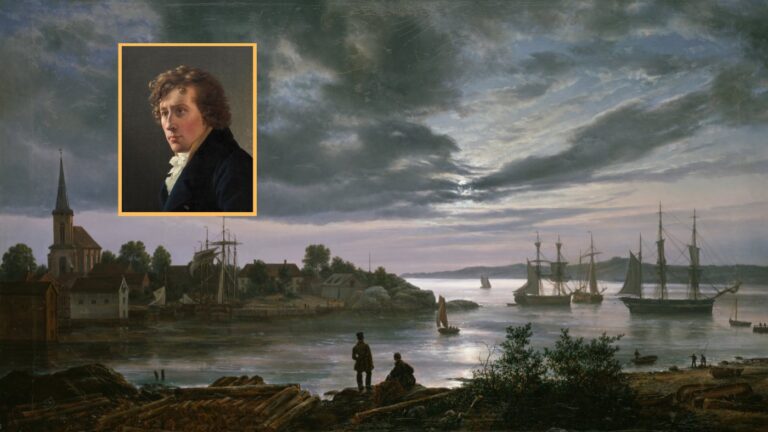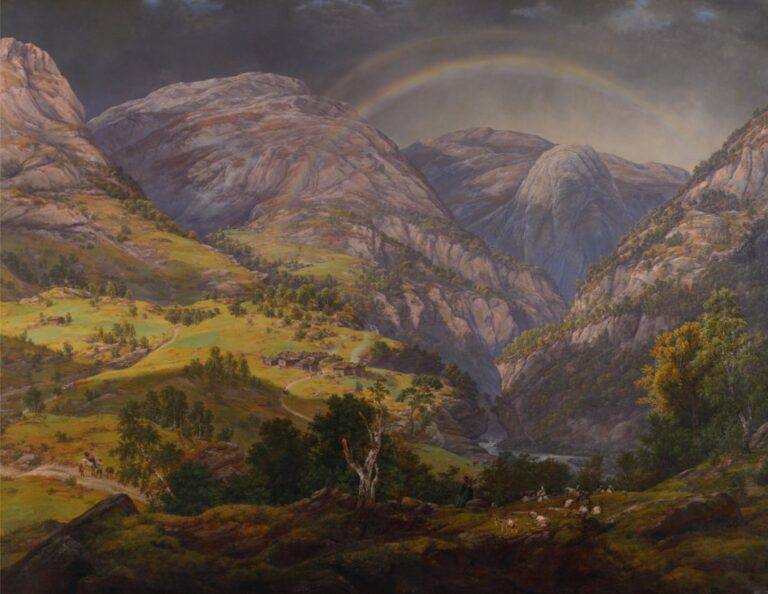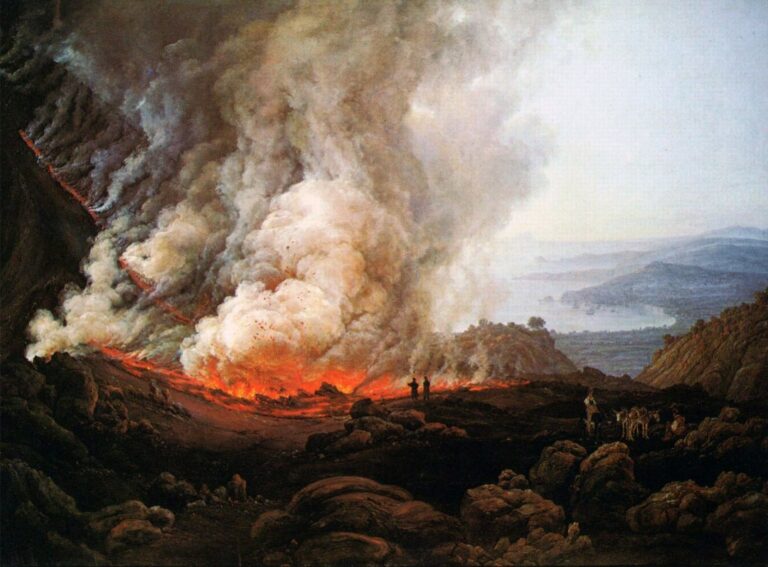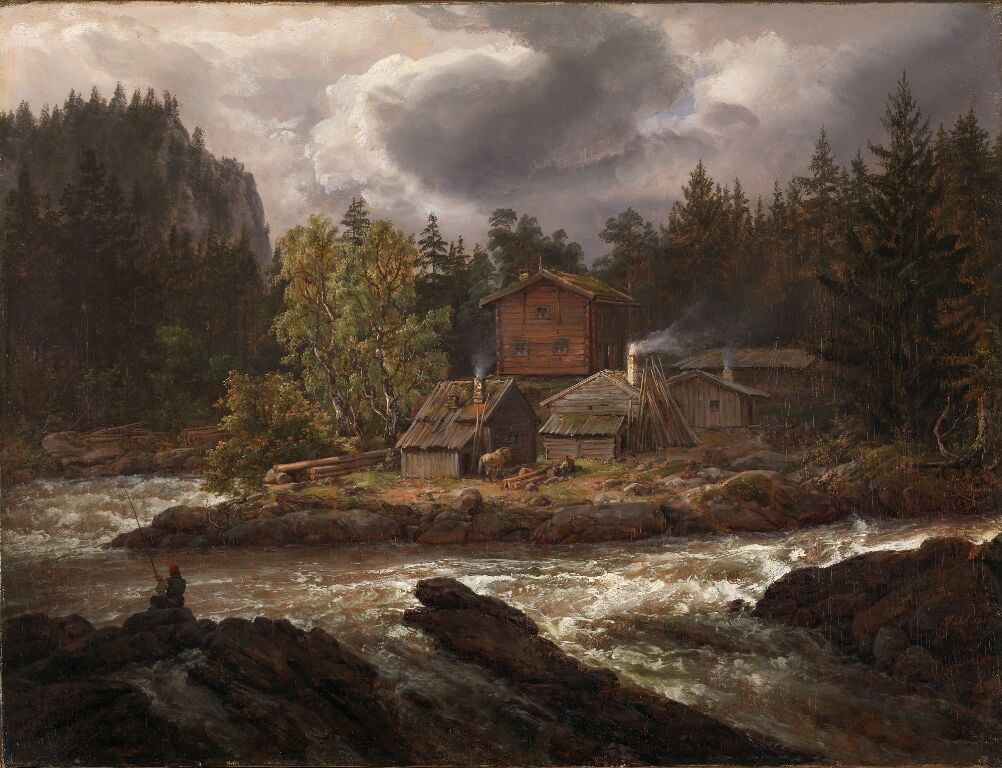Often hailed as the father of Norwegian landscape painting, Johan Christian Dahl helped shape not only the art of a nation but the very way Norwegians see their own country.
More than 150 years after his death, Dahl’s influence continues to resonate in galleries, textbooks, and the wild landscapes that inspired him.

Born in Bergen in 1788 to a humble family, Dahl’s early life gave little indication of the global impact he would later have. His father was a fisherman and ferryman, and Dahl was expected to follow a similar path.
But his artistic talent was evident early on, and local patrons helped him gain entry to the Royal Danish Academy of Fine Arts in Copenhagen.
Shaping a New Vision of Norway
At a time when Norway had yet to develop its own artistic identity, Dahl began to define one.
Influenced by the Dutch landscape masters and by the German Romantic tradition, Dahl forged a style that was both dramatic and grounded in real observation. His works were not idealised fantasies—they were recognisably Norwegian.
Fjords, waterfalls, rugged mountains and turbulent skies dominate his canvases. But more than scenic beauty, Dahl’s paintings conveyed a sense of national pride and emotional depth that helped awaken a cultural consciousness in a young Norway still defining itself after independence from Denmark.
A Life Between Nations
Although Dahl spent most of his adult life in Dresden, where he taught at the Academy of Fine Arts and mingled with the German Romantics (notably Caspar David Friedrich), he returned to Norway often.
These trips were not only personal pilgrimages but working expeditions—sketching fjords and valleys that would later appear in his monumental canvases.
‘View from Stalheim'
Arguably Dahl’s most iconic painting, View from Stalheim (1842) captures the dramatic Nærøydalen valley in Western Norway in all its grandeur. With a sweeping perspective, distant snow-capped peaks, and a rainbow stretching across the scene, the painting blends precise observation with a heightened sense of Romantic drama.

But what truly sets it apart is how it transforms a real Norwegian landscape into a national symbol. Dahl began working on the painting in 1836 and completed it in 1842. It was based on pencil and watercolour sketches he made a decade earlier during his first visit to the high mountain regions of Norway.
From the road near Gudvangen in July 1826, he captured the striking view looking out over the narrow valley, with the peak of Jordalsnuten rising above.
While the final painting follows his original studies closely in both composition and detail—including the sunlight illuminating the village in the foreground—Dahl made deliberate artistic choices to intensify the effect.
He narrowed the valley, gave greater prominence to the mountain peak, and reduced the river’s reappearance from the shadows, enhancing the drama and symbolism of the scene.
The painting was commissioned by Countess Wedel of Bogstad, and in 1914 it was gifted to the National Gallery of Norway by Carl Gustav Wedel-Jarlsberg.
Today, it remains one of the museum’s most treasured works. Though the result is a masterpiece, View from Stalheim was not an easy project for Dahl. He struggled with the painting and, after its completion, largely avoided similarly ambitious canvases.
Critics and historians regard it as one of Dahl’s finest achievements—perhaps the most successful realisation of his lifelong aim: to depict Norwegian nature both realistically and symbolically.
Other artists have since painted the same view, but Dahl’s version remains definitive. More than any of his other works, View from Stalheim helped spark public interest in the site.
The luxury hotel built at Stalheim in 1885, offering visitors the very same view Dahl immortalised, owes its existence in part to this painting.
Other Dahl Masterpieces That Defined a Nation
Dahl's oeuvre is vast, but several other paintings also stand out not only for their artistic quality but for the way they shaped how Norwegians came to see their own landscape.
These works continue to be displayed in national museums and studied by art historians as milestones in Nordic Romanticism.
The Eruption of Vesuvius (1820s)
While better known for his Norwegian landscapes, Dahl’s trip to Italy produced one of his most dynamic series.

Based on his eyewitness experience of Mount Vesuvius erupting, these works blend scientific curiosity with raw Romantic drama. Several versions exist, each showing the fiery spectacle in different moods and compositions.
Shipwreck on the Norwegian Coast (1832)
Nature was not always benevolent in Dahl’s work. This brooding seascape, with a wrecked vessel tossed in stormy waters, highlights the power and danger of Norway’s coastline.
It’s a painting full of movement and emotion—an allegory, perhaps, for the fragility of human life against nature’s might.
Winter at the Sognefjord (1827)
In this quiet, snow-covered fjord scene, Dahl captured the stillness and majesty of the Norwegian winter. Unlike many of his more theatrical works, this painting evokes a contemplative mood, with soft light and subtle tones that celebrate the beauty of cold.
The Stugunøset in the Filefjeld (1851)
One of his later works, this painting was based on a sketch made during a journey through the Filefjell mountain pass. It exemplifies Dahl’s lifelong fascination with mountainous terrain and his ability to render light and atmosphere with precision and feeling.
Beyond the Canvas & an Enduring Legacy
Dahl’s impact wasn’t limited to painting. He was a passionate advocate for preserving Norway’s architectural and cultural heritage. He campaigned to protect stave churches and played a role in restoring the Nidaros Cathedral in Trondheim.
He also helped establish Norway’s National Gallery, ensuring future generations could access and appreciate both Norwegian and international art.
Johan Christian Dahl died in Dresden in 1857, but his connection to Norway remained strong even in death. In 1934, his remains were returned to Bergen, where he was reburied at St. Jakob’s Church.
Where to See Dahl's Work Today
For many Norwegians, Dahl’s landscapes are windows into the soul of a nation. His legacy lives on not only in the cultural memory of Norway but also in the museum collections where his masterpieces continue to inspire visitors.
The National Museum in Oslo holds several of Dahl’s most important works, including View from Stalheim (1842), which is currently on display in the museum’s “Forces of Nature” exhibition.

Other highlights in the collection include Winter at the Sognefjord (1827), Shipwreck on the Norwegian Coast (1832), and The Stugunøset in the Filefjeld (1851), each of which showcases a different facet of Dahl’s ability to portray the power and beauty of the Norwegian landscape.
In his hometown of Bergen, KODE – the Art Museums of Bergen boasts one of the most comprehensive collections of Dahl’s work. Visitors can view pieces such as Birch Tree in a Storm, View of Bergen Harbor, and several early landscapes.
Outside of Norway, Dahl’s legacy is especially visible in Dresden, where he lived and taught for much of his life. The Galerie Neue Meister in Dresden includes a number of his paintings, particularly those reflecting his time in Germany and his travels across Europe.
Further afield, The Metropolitan Museum of Art in New York holds several of Dahl’s works, including Two Men Before a Waterfall at Sunset and An Eruption of Vesuvius, which reflect his mastery of light, atmosphere, and Romantic storytelling.
Other institutions with Dahl paintings in their collections include the National Gallery in London, the Neue Pinakothek in Munich, and the National Gallery of Denmark in Copenhagen, reflecting his stature as a leading figure in 19th-century European art.
For those who want to go beyond the gallery walls, visiting the village of Stalheim in western Norway offers a unique opportunity to see the very landscape that inspired Dahl’s most iconic painting. The view remains remarkably similar, and the hotel built there in 1885 still welcomes travellers today.
In an age of climate change, tourism, and rapid development, Dahl’s art serves as a reminder of the raw, untamed beauty of Norway’s natural landscape and of the importance of protecting it.
His legacy lives on in every artist who finds inspiration in nature and in every Norwegian who sees their country reflected in his majestic scenes.

